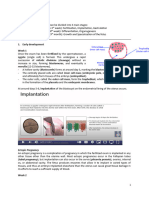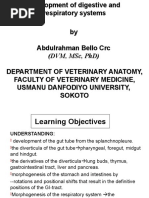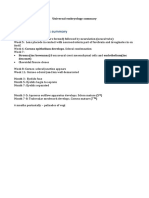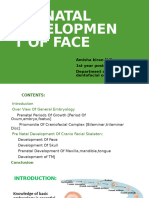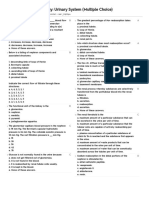270 - Embryology Physiology) Development & Embryology of The GI Tract - Part 1
270 - Embryology Physiology) Development & Embryology of The GI Tract - Part 1
Uploaded by
Zade BawiCopyright:
Available Formats
270 - Embryology Physiology) Development & Embryology of The GI Tract - Part 1
270 - Embryology Physiology) Development & Embryology of The GI Tract - Part 1
Uploaded by
Zade BawiOriginal Title
Copyright
Available Formats
Share this document
Did you find this document useful?
Is this content inappropriate?
Copyright:
Available Formats
270 - Embryology Physiology) Development & Embryology of The GI Tract - Part 1
270 - Embryology Physiology) Development & Embryology of The GI Tract - Part 1
Uploaded by
Zade BawiCopyright:
Available Formats
Last edited: 8/5/2021
12. DEVELOPMENT OF THE GIT PART 1
Development of the GIT Part 1 Medical Editor: Jan Camille Santico
OUTLINE II) EMBRYONIC FOLDING
I) TRILAMINAR DISC (A) SAGITTAL PLANE
II) EMBRYONIC FOLDING
III) REVIEW QUESTIONS
IV) REFRENCES
I) TRILAMINAR DISC
At the 3 week of development, the embryo is a
rd
trilaminar disc
o Made up ectoderm, mesoderm, and endoderm
Figure 2. Sagittal Plane of Embryo
Underneath the surface ectoderm is the neural tube and
notochord The sagittal view shows the cranial and caudal ends of
Flanking the notochord is the intraembryonic mesoderm, the gut tube
which can be divided into: During the 4th week of development, folding along the
o Paraxial mesoderm sagittal plane will form the cranial and caudal folds
o Intermediate mesoderm o The endoderm lining will expand outwards and fold
o Lateral plate mesoderm The gut tube can be divided into three parts:
Somatic layer o Cranial – foregut
Splanchnic layer o Middle – midgut
Underneath the mesoderm is the endoderm, which forms o Caudal – hindgut
the epithelial lining of the gastrointestinal organs, Mesoderm surrounds the gut tube
accessary organs, and glands o Mesoderm cells at the cranial end will help form the
Above the ectoderm is the amniotic sac pericardiac cavity and the heart
Below the endoderm is the yolk sac, which helps in the
Neural crest cells from the ectoderm layer will develop
synthesis of red blood cells
into important ganglia for the GIT (e.g. myenteric plexus)
o The yolk sac also secretes the extraembryonic
The yolk sac is connected to the midgut via the
mesoderm, which surrounds the yolk sac and
vitelline/omphalomesenteric duct
amniotic cavity
The two openings of the digestive tract are derived from
The somatic and splanchnic mesoderm develop a cavity areas of fusion between the ectoderm and endoderm (of
called the intraembryonic coelom, which allows the two the gut tube)
mesoderm layers to become continuous with the o The oropharyngeal membrane (foregut) will
extraembryonic mesoderm perforate to form the mouth
Eventually, the embryo will fold along the transverse and o The cloacal membrane (hindgut) will perforate to
sagittal plane form the urogenital tract and anus
By the 6th week of development, the vitelline duct will
obliterate, leaving the umbilical cord
o Meckel’s Diverticulum
An outpouching of the small intestine
Results from the failure of the vitelline duct to
obliterate, leaving behind a connection between
the midgut and the anterior abdominal wall
Also during the 6th week, the small intestines will form a
loop and herniate through the umbilical cord
o The developing organs within the abdominal cavity
push out the small intestines
During the 11th week, the abdominal cavity has increased
in size, so the intestinal loop is pulled back in
Figure 1. Trilaminar Disc o Omphalocele
Results from the failure of the intestinal loop to
return inside the abdominal cavity
Can be detected through fetal ultrasound or serum
alpha fetoprotein levels of the mother
Development of the GIT Part 1 EMBRYOLOGY: Note #1. 1 of 3
(B) TRANSVERSE PLANE (2) Retroperitoneal Organs
Retroperitoneal organs have no mesentery and are
located outside the peritoneum
Instead of visceral/parietal serosa, they have adventitia
o Dense, irregular fibrous connective tissue that
anchors retroperitoneal organs to the abdominal wall
o Does not provide mobility
Examples:
o Kidneys
o Adrenal glands
o Parts of the duodenum
(i) Primary Retroperitoneal Organs
• Organs which never had a mesentery
• Located posterior to the peritoneum
• Examples:
o Abdominal aorta
o Inferior vena cava
o Adrenal glands
o Kidneys
o Ureter
o Bladder
Figure 3. Transverse Plane of Embryo o Lower rectum
• The transverse plane shows a cross-section of the o Esophagus
embryo
(ii) Secondary Retroperitoneal Organs
• The endoderm will fold outwards and downwards. It will
get sucked in and pushed out, forming the vitelline duct • Organs with mesenteries that were obliterated
• The amniotic cavity starts folding down • Examples:
• The splanchnic mesoderm will surround the vitelline duct o 2nd, 3rd, and 4th parts of the duodenum
and yolk sac o Ascending colon
• The somatic mesoderm will line the inner walls of the o Descending colon
amniotic cavity o Head and body of the pancreas
• Once the vitelline duct obliterates, the two endoderm
folds can merge, forming a closed gut tube
o Gastroschisis
The lateral folds fail to fuse, resulting in the
herniation of abdominal contents
The herniated intestines are not covered in
peritoneum, which could irritate the abdominal
cavity
(1) Intraperitoneal Organs
The splanchnic mesoderm will surround the gut tube,
forming a part of the GI tract (submucosa up to visceral
peritoneum)
The somatic mesoderm will line the inner walls of the
abdominal cavity (parietal peritoneum)
The visceral and parietal peritoneum connect/meet at the Figure 5. Retroperitoneal Organs
mesenteries, a ligament which connects
organs/structures to the abdominal wall and provides
mobility
Any organ with a mesentery is considered intraperitoneal
Examples:
o Stomach
o Liver
o Spleen
o Transverse colon
Figure 4. Intraperitoneal Organs
2 of 3 EMBRYOLOGY: Note #12. Development of the GIT Part 1
III) REVIEW QUESTIONS
1) Meckel’s diverticulum results from ____
a) Failure of the endodermal folds to fuse
b) Failure of the vitelline duct to form
c) Failure of the vitelline duct to regress
d) Failure of the intestinal loop to return inside the
abdominal cavity
2) Which structure secretes the extraembryonic
mesoderm?
a) Yolk sac
b) Amniotic sac
c) Notochord
d) Intraembryonic coelom
3) All of the following structures are intraperitoneal,
EXCEPT
a) Stomach
b) Jejunum
c) Transverse Colon
d) Ascending Colon
4) Which of the following statements is TRUE?
a) Omphalocele results from the failure of the lateral
endodermal folds to fuse
b) The liver is a retroperitoneal organ
c) The yolk sac is connected to the hindgut via the
vitelline duct.
d) Retroperitoneal organs are covered with adventitia
5) Which of the following is NOT a primary
retroperitoneal organ?
a) Adrenal gland
b) Pancreas
c) Bladder
d) Lower Rectum
CHECK YOUR ANSWERS
IV) REFRENCES
Development of the GIT Part 1 EMBRYOLOGY: Note #1. 3 of 3
You might also like
- List of Video Lectures Available in Our Video BankDocument25 pagesList of Video Lectures Available in Our Video Bankzeeshannajeeb80% (10)
- Ninja Nerd Embryology Notes CompleteDocument111 pagesNinja Nerd Embryology Notes Completezipporahwaithera404No ratings yet
- 2003NBDE 1 ExplanationsDocument110 pages2003NBDE 1 Explanationsfly_jfz100% (3)
- Development & Embryology of The GI Tract - Part 1 (2) AtfDocument3 pagesDevelopment & Embryology of The GI Tract - Part 1 (2) Atfhamedansam898No ratings yet
- M.01 - Digestive System - Part1Document7 pagesM.01 - Digestive System - Part1Raymund Dan AldabaNo ratings yet
- Development of GI TractDocument60 pagesDevelopment of GI TractAnnaAnnalisyaNo ratings yet
- Muscular System Body Cavity and Diaphargm Brig (R) Liaqat Ali MinhasDocument38 pagesMuscular System Body Cavity and Diaphargm Brig (R) Liaqat Ali Minhasvickyjee1No ratings yet
- NCM107 PediatricsDocument11 pagesNCM107 PediatricsKM PanganibanNo ratings yet
- Elzatona Written 2023Document10 pagesElzatona Written 2023mahmoud ezzeldeenNo ratings yet
- Embryology Notes emDocument25 pagesEmbryology Notes emAnonymous IwWT90Vy100% (1)
- 3rd WEEK OF DEV_RDocument90 pages3rd WEEK OF DEV_RSiti Nur FazlinaNo ratings yet
- Body Cavity Diaphragm MesentryDocument16 pagesBody Cavity Diaphragm Mesentryshallonngabirano29No ratings yet
- Folds of Peritoneum: Abdomen and PelvisDocument100 pagesFolds of Peritoneum: Abdomen and PelvissrisakthiNo ratings yet
- MosbyDocument53 pagesMosbySharah ZamoraNo ratings yet
- L1-Development of Male Genital SystemDocument25 pagesL1-Development of Male Genital SystemAhmed AbdellaNo ratings yet
- Development of GIT - IDocument69 pagesDevelopment of GIT - IAarushi JainNo ratings yet
- Week 6 - Day 1 - Development of Body CavitiesDocument46 pagesWeek 6 - Day 1 - Development of Body CavitiesNsikan GabrielNo ratings yet
- Development of The Diaphragm-1Document5 pagesDevelopment of The Diaphragm-1amygod2003No ratings yet
- GA&E 14 - Bilaminar Germ DiscDocument34 pagesGA&E 14 - Bilaminar Germ DiscSu ZikaiNo ratings yet
- General Zoology Handout Zoology 10 Lab Laboratory Exercise 8Document4 pagesGeneral Zoology Handout Zoology 10 Lab Laboratory Exercise 8Rey Malvin SG PallominaNo ratings yet
- Development of Male Reproductive SystemDocument21 pagesDevelopment of Male Reproductive SystemOgunsusi DamilolaNo ratings yet
- Embryology in Weeks SimpleDocument38 pagesEmbryology in Weeks SimpleFrancesca vitaleNo ratings yet
- Esophagus - Anatomy and Development - GI Motility OnlineDocument21 pagesEsophagus - Anatomy and Development - GI Motility OnlineMaria Fernanda VargasNo ratings yet
- The Gut Tube and The Body CavitiesDocument20 pagesThe Gut Tube and The Body CavitiesKyla CalsoNo ratings yet
- CAVITIES FORMATION - Ana Sorriano and Bruna PauliniDocument14 pagesCAVITIES FORMATION - Ana Sorriano and Bruna Paulinibrunapaulini1No ratings yet
- 0 Review Embryoloby 2024.3 2Document34 pages0 Review Embryoloby 2024.3 2sh.farangissNo ratings yet
- Lec5 Third Week Trilaminar Germ DiscDocument6 pagesLec5 Third Week Trilaminar Germ DiscqeiqzombeNo ratings yet
- Development Foregut 24Document23 pagesDevelopment Foregut 24myarjddbzNo ratings yet
- 1 s2.0 S0039610905704084 MainDocument25 pages1 s2.0 S0039610905704084 Mainjuan pablo mesa mejiaNo ratings yet
- Embryology: The Anatomic Basis of Fetal MedicineDocument55 pagesEmbryology: The Anatomic Basis of Fetal Medicinejidat lawak100% (1)
- .By Prof Faiz. Shaikh LCMD - Development of Body CavitiesDocument9 pages.By Prof Faiz. Shaikh LCMD - Development of Body Cavitiesumernadeem73.unNo ratings yet
- Lec8 Gut Tube and Body Cavities 638643330615052977Document5 pagesLec8 Gut Tube and Body Cavities 638643330615052977qeiqzombeNo ratings yet
- 4Document9 pages4Marielle Anne TuazonNo ratings yet
- 3rd Week DevelopmentDocument26 pages3rd Week Developmentaimi Batrisyia100% (1)
- Saint Louis University School of Medicine Mmxxii: Dr. Laygo - October 22, 2020Document37 pagesSaint Louis University School of Medicine Mmxxii: Dr. Laygo - October 22, 2020Djan Kurvie ValencerinaNo ratings yet
- Exercise 7 Embryology - ORNOPIAABELLANA.Document11 pagesExercise 7 Embryology - ORNOPIAABELLANA.Shree Mena OrnopiaNo ratings yet
- 38 AnswersDocument8 pages38 AnswersJasmine Nicole EnriquezNo ratings yet
- Small Intestine PhysiologyDocument6 pagesSmall Intestine PhysiologySIUSANTO HadiNo ratings yet
- Embryology Notes emDocument18 pagesEmbryology Notes emLuqman AfifNo ratings yet
- Anatomi ServiksDocument12 pagesAnatomi ServiksIda Ayu ApsariNo ratings yet
- Monica MapagbigayDocument13 pagesMonica MapagbigayCarlyn AguasNo ratings yet
- Development of Cardiovascular System PDFDocument58 pagesDevelopment of Cardiovascular System PDFVizhiNo ratings yet
- Digestive and Respiratory SystemDocument65 pagesDigestive and Respiratory SystemAbdul BelloNo ratings yet
- Universal Embryology SummaryDocument6 pagesUniversal Embryology SummaryJason TonioloNo ratings yet
- 1 Review of Anatomy and Physiology of The StallionDocument23 pages1 Review of Anatomy and Physiology of The StallionMaria Margarita Molina PuentesNo ratings yet
- Types of Extra Embryonic MembranesDocument11 pagesTypes of Extra Embryonic MembranesDrAbhilasha SharmaNo ratings yet
- Growth of FaceDocument88 pagesGrowth of FaceAmisha KiranNo ratings yet
- Developmemt of the Embryo-1Document29 pagesDevelopmemt of the Embryo-1Bhavik YadavNo ratings yet
- 2_5251708245147399011Document12 pages2_5251708245147399011wwwxfyuNo ratings yet
- Block Vii Module 1 Cheat Sheet PDFDocument32 pagesBlock Vii Module 1 Cheat Sheet PDFMark FuerteNo ratings yet
- The Anatomy and Physiology of The Small Bowel: David GourevitchDocument2 pagesThe Anatomy and Physiology of The Small Bowel: David GourevitchNur Ainaa Almardhiyah TubungNo ratings yet
- Embryonic Period KMMDocument34 pagesEmbryonic Period KMMDaren CheongNo ratings yet
- lec 2,3,4Document7 pageslec 2,3,4jimadaddy2021No ratings yet
- Embryology of Body Cavities, Mesenteries and DiaphragmDocument35 pagesEmbryology of Body Cavities, Mesenteries and DiaphragmKankomba MuleyaNo ratings yet
- HANDOUTS-Gut-Tube-and-Body-CavitiesDocument7 pagesHANDOUTS-Gut-Tube-and-Body-CavitiesDucut Kyla ClarisseNo ratings yet
- Vi Semester B. SC Zoology Practicals Study of Embryological Slides Frog BlastulaDocument11 pagesVi Semester B. SC Zoology Practicals Study of Embryological Slides Frog BlastulaSuchitra Sharma100% (1)
- Camp's Zoology by the Numbers: A comprehensive study guide in outline form for advanced biology courses, including AP, IB, DE, and college courses.From EverandCamp's Zoology by the Numbers: A comprehensive study guide in outline form for advanced biology courses, including AP, IB, DE, and college courses.No ratings yet
- Cleft Lip and Palate Management: A Comprehensive AtlasFrom EverandCleft Lip and Palate Management: A Comprehensive AtlasRicardo D. BennunNo ratings yet
- Digestive-System NotesDocument4 pagesDigestive-System NotesPiyush RoyNo ratings yet
- Pituitary Tumor & AcromegalyDocument32 pagesPituitary Tumor & Acromegalysam840720No ratings yet
- Stop-Acei Trial Journal ClubDocument3 pagesStop-Acei Trial Journal Clubapi-648891519No ratings yet
- SCIENCE 10 - Nervous SystemDocument29 pagesSCIENCE 10 - Nervous Systemcatalancsj10No ratings yet
- Duodenal InjuryDocument54 pagesDuodenal InjuryTony HardianNo ratings yet
- CKD PathophysiologyDocument1 pageCKD Pathophysiologynursing concept mapsNo ratings yet
- Renal MCQ 1Document2 pagesRenal MCQ 1Aziz100% (2)
- Worksheet 3 RAD101Document11 pagesWorksheet 3 RAD101Freonamie LavesoresNo ratings yet
- Chapter 3 Biological Basis of BehaviorDocument26 pagesChapter 3 Biological Basis of BehaviorSyed MuneerNo ratings yet
- Unit 10 - Nervous SystemDocument5 pagesUnit 10 - Nervous Systemlola.konjevicNo ratings yet
- Anatomy - Physiology (Chapter 12 - Heart)Document20 pagesAnatomy - Physiology (Chapter 12 - Heart)Avi ZychNo ratings yet
- CHEMICAL CONTROL & COORDINATION Question Bank Chapter Name MeghaDocument10 pagesCHEMICAL CONTROL & COORDINATION Question Bank Chapter Name Meghajayanthidungavath7032No ratings yet
- Perlis CRF Renal ReplacementDocument65 pagesPerlis CRF Renal ReplacementFikri SeptianNo ratings yet
- SCIE1051Document7 pagesSCIE1051waynerossschoolNo ratings yet
- Adrenal Cortical HormoneDocument28 pagesAdrenal Cortical HormoneTalha MohsinNo ratings yet
- Calcium HomeostasisDocument69 pagesCalcium HomeostasisDr Mirunalini SundaravadiveluNo ratings yet
- Opd SCH 060522Document6 pagesOpd SCH 060522Sonu Singh Kajal0% (1)
- Midterm TestDocument3 pagesMidterm Testuyenthutrantn1976No ratings yet
- Angiology NoteDocument13 pagesAngiology NoteSantosh Bhandari100% (2)
- Haemato-Biochemical Alterations in Dogs Suffering From Chronic Renal FailureDocument6 pagesHaemato-Biochemical Alterations in Dogs Suffering From Chronic Renal FailureBergita PaulinoNo ratings yet
- Basics ECGpediaDocument6 pagesBasics ECGpediaCarina SuarezNo ratings yet
- The Human Reproductive SystemDocument7 pagesThe Human Reproductive SystemAlloiza CaguiclaNo ratings yet
- Homeostasis: The Foundation of Physiology Test Questions: Multiple ChoiceDocument6 pagesHomeostasis: The Foundation of Physiology Test Questions: Multiple ChoiceSenthereng MoaisiNo ratings yet
- Date LAB Topic Lecturer: Anat 216 Lecture, Quiz, Laboratory and Evaluation Schedule Winter Term 2016Document3 pagesDate LAB Topic Lecturer: Anat 216 Lecture, Quiz, Laboratory and Evaluation Schedule Winter Term 2016Emmanuel EséNo ratings yet
- Syrgery Mock 10Document8 pagesSyrgery Mock 10Sergiu CiobanuNo ratings yet
- Digestive System ShuklaDocument56 pagesDigestive System ShuklaUjwal WandhareNo ratings yet
- Severe Cholestasis and Renal Failure Associated With The Use of The Designer Steroid Superdrol™ (Methasteron™) A Case Report and Literature ReviewDocument3 pagesSevere Cholestasis and Renal Failure Associated With The Use of The Designer Steroid Superdrol™ (Methasteron™) A Case Report and Literature ReviewPádraig Ó ĊonġaileNo ratings yet
- LIPS - Histological StructureDocument4 pagesLIPS - Histological StructureivkovictNo ratings yet
- Eeg Lectures 1Document44 pagesEeg Lectures 1Stanley Igwe100% (1)





















